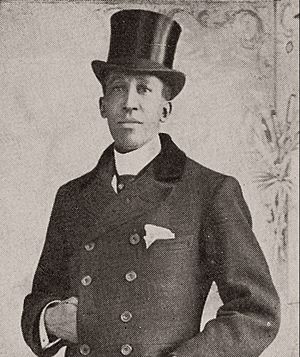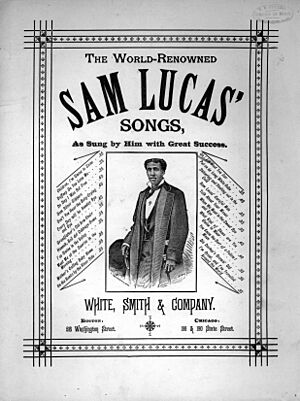Sam Lucas facts for kids
Sam Lucas (born August 7, 1840 – died January 10, 1916) was an American actor, comedian, singer, and songwriter. He was born to parents who were formerly enslaved but had gained their freedom. His exact birth year is not fully known, with some records showing 1839, 1841, 1848, or 1850.
Sam Lucas started his career in blackface minstrel shows. These shows often featured white performers in "blackface" makeup, but later, African American performers also took part. Lucas became one of the first African Americans to move from minstrelsy into more serious acting roles. He appeared in important shows like The Creole Show and A Trip to Coontown. He was also the first black man to play the role of Uncle Tom on both stage and in movies. A famous writer, James Weldon Johnson, called him the "Grand Old Man of the Negro Stage." Even though he started in minstrel shows, Sam Lucas wanted to move beyond them. He was also unique because he performed spirituals (religious songs) in special concerts, like those given by the Fisk Jubilee Singers.
Contents
Early Life and Career Beginnings
Sam Lucas was born Samuel Mildmay Lucas in Washington Court House, Ohio. His parents were free African Americans. As a teenager, he showed a great talent for playing the guitar and singing. He worked as a barber, but his local performances quickly made him well-known.
In 1858, Sam Lucas began his career as a performer. He joined traveling African-American minstrel groups. For the next five years, he sang and acted on stage and even on riverboats. He also wrote music for his shows. He found ways to include his African-American background in these shows. For example, his song "Carve Dat Possum" used a tune from a black religious song. As black minstrel shows became popular, Lucas became one of their first stars. He was especially known for playing funny, yet sometimes sad, characters.
Performing with Famous Troupes
Because of his fame, Sam Lucas could choose where he performed. Throughout his career, he worked with some of the best black minstrel groups. However, he never started his own group. He performed with groups like Lew Johnson's Plantation Minstrels (from 1871 to 1873), Callender's Georgia Minstrels (from 1873 to 1874, and again from 1875 to 1876), and Sprague's Georgia Minstrels (from 1878 to 1879) in Havana, Cuba. After his time in minstrel shows, Lucas began performing in vaudeville.
Jubilee Singer and Composer
Sam Lucas was also a writer and performer of jubilee songs. He called himself a "jubilee singer" and even formed his own jubilee group in 1881. His goal was to feature popular songs by black composers, along with his own character songs. His group did not perform traditional spirituals. Instead, he mixed different types of music, including commercial spirituals, instrumental pieces, and comedy. This created a new kind of concert that was part variety show and part music concert. Besides his own group, "Mr. Sam Lucas and quartet," he worked with many other jubilee groups. These included the Norfolk Jubilee Singers and the Hyers Sisters.
Moving to Dramatic Roles
Sam Lucas tried to perform in shows that were not minstrel-related. After a short return to black minstrelsy, he was performing with Sprague's Georgia Minstrels in 1876.
In 1878, two theater producers, Charles and Gustave Frohman, needed a new idea to help a struggling comedy group. They decided to put on a serious play of Uncle Tom's Cabin with a black man in the main role. Sam Lucas was well-known for his acting skills. Gustave Frohman told Charles to "Get me an Eva and send her down with Sam Lucas. Be sure to tell Sam to bring his diamonds."
First Black Uncle Tom
Sam Lucas became the first African American born in the USA to play Uncle Tom in a serious play in the USA. This happened sometime after July 1878. Before him, Hosea Easton, also from the USA, played the role in Melbourne, Australia, in June 1878. Hackett Coulthurst, from the West Indies, performed it even earlier in Australia in 1867. Lucas's play did not do well in Richmond, Virginia. Even moving the show to Lucas's home state of Ohio could not save it. One critic even joked that "little" Eva was so big she almost squashed another actor. Lucas had to sell his diamonds to pay for the group's trip back to Cincinnati.
Lucas then joined the Hyers Sisters for a play called The Underground Railroad. After that, he went back to performing blackface acts for a while. He also continued to write music. Many of his songs showed a stronger African American viewpoint compared to other black composers. For example, in his song "My Dear Old Southern Home," the lyrics say:
- I remember now my poor wife's face,
- Her cries ring in my ear;
- When they tore me from her wild embrace,
- And sold me way out yere.
- My children sobbed about my knees,
- They've all grown up since then,
- But bress de Lord de good time's come;
- I'se freed by dose Northern men.
Another song by Lucas states, "I nebber shall forget, no nebber, / De day I was sot free."
Later Career and New Shows
In 1890, Sam Lucas was part of The Creole Show by Sam T. Jack. This show is often seen as one of the first African American productions to move away from minstrelsy.
Lucas got married during this time. After The Creole Show, he and his wife performed in various theaters and museums. In 1898, he performed in Boston in A Trip to Coontown. This was a very important show because it was the first black production to have only African American writers, directors, and producers. It was also the first black musical comedy to completely break away from minstrel shows.
From 1905 to 1906, he starred in Rufus Rastus, directed by Ernest Hogan. In 1907, Lucas was in another musical comedy called The Shoe-Fly Regiment. This show ran from June to August 1907 in New York City. The story took place in Alabama and the Philippines. Lucas played Brother Doolittle, a member of the "Bode of Education."
Lucas later performed in another musical comedy called The Red Moon. In this show, he played Bill Webster, a barber. The Red Moon ran in May 1909 and was set in a fictional town called "Swamptown, Virginia."
In 1908, he became a founding member of a professional theater club called The Frogs. In 1913, he took part in The Frog Follies.
Lime Kiln Field Day (1913)
In 1913, Sam Lucas appeared in an unfinished movie called Lime Kiln Field Day. It was made by the Biograph Company. The film was not completed at the time. However, in 2014, the Museum of Modern Art put the footage together. They had saved the film cans from a storage vault in 1938.
Uncle Tom's Cabin (1914)
In 1914, Sam Lucas played his famous role of Uncle Tom again. This time, it was in a movie version of Harriet Beecher Stowe's novel Uncle Tom's Cabin. This film was directed by William Robert Daly. Lucas is generally known as the first black man to play Uncle Tom in a movie. Before this, white actors often played the character in blackface. The movie was released on August 10, 1914.
This silent film was shot in the Southern United States. It showed scenes of cotton fields and Mississippi riverboats. When the movie was shown in theaters, organs or other instruments played music along with it. In 2012, this film was added to the National Film Registry, which recognizes important movies.
Personal Life
Sam Lucas was married several times. His second wife was Carrie Melvin. They married in Boston, Massachusetts, on August 11, 1886.
Carrie Melvin Lucas was a talented musician. She played the violin and cornet, and she was also an actress. Sam and Carrie had one daughter together, Marie Lucas (1891–1947). Marie grew up to be a successful pianist, trombonist, arranger, and conductor. Sam and Carrie performed together in vaudeville shows, but they later divorced in 1899. Marie and Sam also worked together later in their careers.
Death
After finishing the movie Uncle Tom's Cabin, Sam Lucas died in 1916. He passed away from pneumonia, after suffering from liver disease for many years.
See also
- 1883 in music



